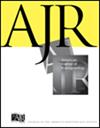了解肺癌筛查率报告的巨大转变:美国肺脏协会《肺癌状况报告》中的方法论变化。
IF 4.7
2区 医学
Q1 RADIOLOGY, NUCLEAR MEDICINE & MEDICAL IMAGING
引用次数: 0
摘要
本文章由计算机程序翻译,如有差异,请以英文原文为准。
Understanding the Dramatic Shift in Reported Lung Cancer Screening Rates: Methodologic Changes in the American Lung Association's State of Lung Cancer Report.
The American Lung Association's State of Lung Cancer Report showed a dramatic increase in national lung cancer screening rates from 4.5% in 2023 to 16.0% in 2024. This apparent improvement stems from a methodologic change-switching from the American College of Radiology lung cancer screening registry to the Behavioral Risk Factor Surveillance System. This Viewpoint examines this transition, discusses research and policy implications, and highlights the importance of understanding methodologic changes when interpreting screening statistics.
求助全文
通过发布文献求助,成功后即可免费获取论文全文。
去求助
来源期刊
CiteScore
12.80
自引率
4.00%
发文量
920
审稿时长
3 months
期刊介绍:
Founded in 1907, the monthly American Journal of Roentgenology (AJR) is the world’s longest continuously published general radiology journal. AJR is recognized as among the specialty’s leading peer-reviewed journals and has a worldwide circulation of close to 25,000. The journal publishes clinically-oriented articles across all radiology subspecialties, seeking relevance to radiologists’ daily practice. The journal publishes hundreds of articles annually with a diverse range of formats, including original research, reviews, clinical perspectives, editorials, and other short reports. The journal engages its audience through a spectrum of social media and digital communication activities.

 求助内容:
求助内容: 应助结果提醒方式:
应助结果提醒方式:


